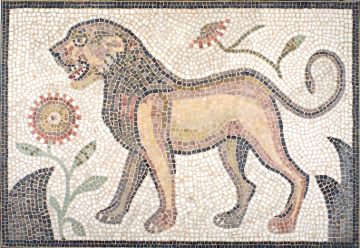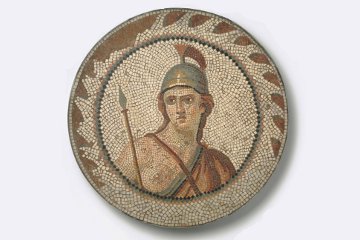Naro and Women's Lib
| Hammam Lif | 36 44 03.87N 10 19 37.67E | The town where the Naro mosaics were found is now a suburb of nearby Tunis. |
In the latter part of the 1800s, when the French and Italians were building their empires in north Africa, they became aware of the importance of the ruins with which they were surrounded. Unfortunately this awareness was not always intelligent and there are ample records of Roman buildings being demolished so that their stones could be used to build roads or farmhouses.
Fortunately this phase did not last long and though the losses were irreparable, there was still plenty left to investigate when the scholars and savants started to explore the ruins and understand their importance. At first their interest was almost exclusively in either classical Roman or early Christian and many churches were excavated, including a surprisingly large number belonging to the Donatist sect.
During the last great persecution under Diocletian a number of church leaders gave in to torture or the threat of it and either apostatised or - which was considered just as bad - handed over the sacred Scriptures to be burned. When the persecution ended those who had been more faithful were divided into two groups: one group recognised the human weakness of those who had yielded and were prepared to forgive and forget; the other group was rather more rigorous and refused to accept church leaders who had been unfaithful to their trust.
When the official church threw its weight on the side of forgiveness - largely, one suspects, because some useful administrators were among the apostates - the stricter group under the leadership of a certain Donatus withdrew and set up their own rival church which, for a time, seemed likely to take over the Christian movement in north Africa. In fact, it was only defeated by the intervention of the civil power on the side of the official church.
The surprise occasioned by the realisation that many of these large buildings and martyriums were "heretical" was nothing to the surprise that followed another discovery on Feb 17, 1883, when Captain Ernest de Prudhomme wanted to turn his quarters at Hammam Lif in Tunisia into a garden. He ordered his men to dig his back yard and fortunately was watching when almost the first spadeful turned up a mass of tesserae, the little stone blocks that make up a mosaic.
In an instant Captain Prudhomme turned from amateur gardener to amateur archaeologist and over the next few months uncovered the remains of a large synagogue, the first ancient synagogue found in modern times.

| |
| A lion from the Naro mosaics. The original is 28" x 6" in size. |
The building, which had fifteen or sixteen rooms (depending on whether you classed some of the spaces as rooms or corridors), appeared from the outside to be an ordinary house. This may reflect the increasing disfavour with which Jews were viewed, for in AD 415 the emperor Honorius issued a decree forbidding the construction of new synagogues and his successor, Theodosius II, forbade even the repair of existing ones.
Inside, however, no expense was spared on the building. Prudhomme uncovered some 25 large mosaics (one or two probably came from a secular building next door to the synagogue because their subject matter appears most unlikely to have figured in a religious building). When he retired from the army he took the mosaics back to France with him - though what he intended to do with them is not clear - and after his death they passed through several hands before most of them ended up in the Brooklyn Museum in America.

| |
| Even less expected than figurative art in a Jewish synagogue is this allegorical representation of "Roma" - Rome. |
The surprise came from the fact that the mosaics were not just simple geometric patterns, which is what one would have expected from Rabbinical dictates against the use of "graven images". The subject matter consisted of a wide range of birds, fish and animals: peacocks that symbolised eternal life; a fish and a dolphin appeared in a scene that depicted Creation; a palm tree and a grape vine may indicate Paradise, for they are depicted in a manner similar to the way in which they are used in Christian churches of the same period.
Perhaps most surprising was the panel that contained a Latin dedicatory inscription: "Your servant, Julia Nap, at her own expense, paved the holy synagogue of Naro with mosaic for her salvation." Women were greatly suppressed in the Rabbinical teachings of the time, but I suppose that money talks in any era - and in fact, of the 300 synagogues that have been discovered since, fully one third of the donors were women, showing that whatever the rabbis might have said, in daily life women wielded a lot of clout.
The Naro mosaics are on temporary display in the Brooklyn Museum at the moment (2006). It is not clear what will happen to them when the exhibition ends. Presumably they will go back into storage, which would be a shame.





